
Noah appears as the last of the Antediluvian patriarchs in the traditions of Abrahamic religions. His story appears in the Hebrew Bible, the Quran and Baha'i writings. Noah is referenced in various other books of the Bible, including the New Testament, and in associated deuterocanonical books.

Methuselah was a biblical patriarch and a figure in Judaism, Christianity, and Islam. He had the longest lifespan of all those given in the Bible, having died at the age of 969. According to the Book of Genesis, Methuselah was the son of Enoch, the father of Lamech, and the grandfather of Noah. Elsewhere in the Bible, Methuselah is mentioned in genealogies in 1 Chronicles, Genesis, and the Gospel of Luke.

Noah's Ark is the ship in the Genesis flood narrative through which God spares Noah, his family, and examples of all the world's animals from a global deluge. The story in Genesis is repeated, with variations, in the Quran, where the Ark appears as Safinat Nūḥ and al-fulk.

Noah, also known as Nuh, is recognized in Islam as a prophet and messenger of God. He is one of the Ulu'l azm prophets. Noah's mission was to warn his people, who were plunged in depravity and sin. God charged Noah with the duty of preaching to his people, advising them to abandon idolatry and to worship only God and to live good and pure lives. Although he preached the Message of God with zeal, his people refused to mend their ways, leading to building the Ark and the Deluge, the Great Flood. In Islamic tradition, it is disputed whether the Great Flood was a global or a local one. Noah's preaching and prophethood spanned 950 years according to the Quran, Ahadith and Tafsir.

A flood myth or a deluge myth is a myth in which a great flood, usually sent by a deity or deities, destroys civilization, often in an act of divine retribution. Parallels are often drawn between the flood waters of these myths and the primaeval waters which appear in certain creation myths, as the flood waters are described as a measure for the cleansing of humanity, in preparation for rebirth. Most flood myths also contain a culture hero, who "represents the human craving for life".

Many Waters is a 1986 novel by Madeleine L'Engle, part of the author's Time Quintet. The title is taken from the Song of Solomon 8:7: "Many waters cannot quench love, neither can the floods drown it. If a man were to give all his wealth for love, it would be utterly scorned."
Hud is the 11th chapter (Surah) of the Quran and has 123 verses (ayat). It relates in part to the prophet Hud. Regarding the timing and contextual background of the revelation, it is an earlier "Meccan surah", which means it is believed to have been revealed in Mecca, instead of later in Medina.

The Bible: In the Beginning... is a 1966 religious epic film produced by Dino De Laurentiis and directed by John Huston. It recounts the first 22 chapters of the Biblical Book of Genesis, covering the stories from The Creation and Adam and Eve to the binding of Isaac.

Noach, Noiach, Nauach, Nauah, or Noah is the second weekly Torah portion in the annual Jewish cycle of Torah reading. It constitutes Genesis 6:9–11:32. The parashah tells the stories of the Flood and Noah's Ark, of Noah's subsequent drunkenness and cursing of Canaan, and of the Tower of Babel.
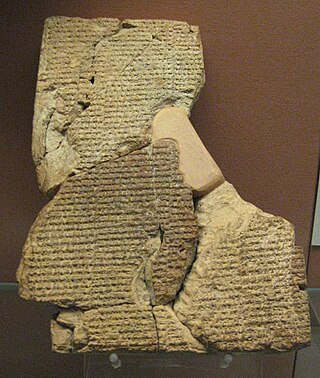
Ut-napishtim or Uta-na’ishtim, Atra-Hasis, Ziusudra (Sumerian), Xisuthros is a character in ancient Mesopotamian mythology. He is tasked by the god Enki to create a giant ship to be called Preserver of Life in preparation of a giant flood that would wipe out all life. The character appears in the Epic of Gilgamesh.
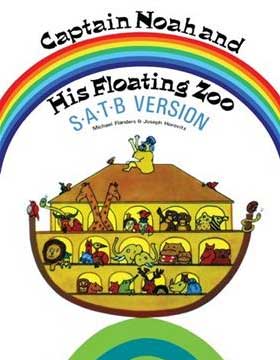
Captain Noah and His Floating Zoo (1970) is a children's cantata composed in a popular style for unison or two-part voices and piano, with optional bass and drums. The libretto by Michael Flanders is an adaptation of the Biblical tale of Noah found in Genesis chapters 6–9. It is one of a series of "pop cantatas" commissioned for school use by Novello, including The Daniel Jazz (1963) by Herbert Chappell, Jonah-Man Jazz (1966) by Michael Hurd and Joseph and the Amazing Technicolor Dreamcoat by Andrew Lloyd Webber (1968).

Many references to ravens exist in world lore and literature. Most depictions allude to the appearance and behavior of the wide-ranging common raven. Because of its black plumage, croaking call, and diet of carrion, the raven is often associated with loss and ill omen. Yet, its symbolism is complex. As a talking bird, the raven also represents prophecy and insight. Ravens in stories often act as psychopomps, connecting the material world with the world of spirits.

Allusions in rabbinic literature to the Biblical character Noah, who saved his family and representatives of all the animals from a great flood by constructing an ark, contain various expansions, elaborations and inferences beyond what is presented in the text of the Bible itself.

Jewish mythology is the body of myths associated with Judaism. Elements of Jewish mythology have had a profound influence on Christian mythology and on Islamic mythology, as well as on Abrahamic culture in general. Christian mythology directly inherited many of the narratives from the Jewish people, sharing in common the narratives from the Old Testament. Islamic mythology also shares many of the same stories; for instance, a creation-account spaced out over six periods, the legend of Abraham, the stories of Moses and the Israelites, and many more.

Doves, typically domestic pigeons white in plumage, are used in many settings as symbols of peace, freedom, or love. Doves appear in the symbolism of Judaism, Christianity, Islam and paganism, and of both military and pacifist groups.
The Quran, the central religious text of Islam, contains references to more than fifty people and events also found in the Bible. While the stories told in each book are generally comparable, there are also some notable differences. Knowing that versions written in the Hebrew Bible and the Christian New Testament does predate the Quran, scholars recognize the borrowing from Persian, Jewish and Christian texts. Muslims believe the Quran to be direct knowledge from an omnipotent God. As such, some Muslims believe that the earlier versions are distorted through flawed processes of transmission and interpretation over time, and consider the Quran's version to be more accurate.
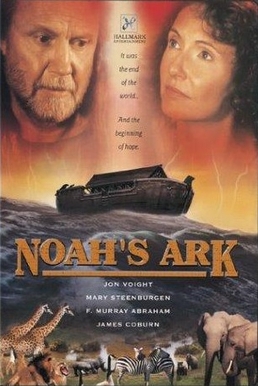
Noah's Ark is a 1999 American-Australian television miniseries directed by John Irvin and starring Jon Voight, Mary Steenburgen, F. Murray Abraham, Carol Kane, Jonathan Cake, Alexis Denisof, Emily Mortimer, Sydney Tamiia Poitier, and James Coburn. The film tells the Biblical story of Noah's Ark from the Book of Genesis. It was initially televised in the United States, that same year, was also televised in Canada, Germany and Portugal, among other countries.
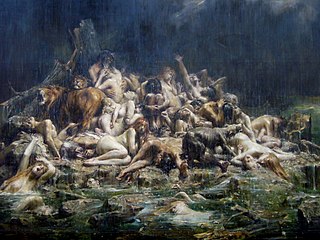
The Genesis flood narrative is a Hebrew flood myth. It tells of God's decision to return the universe to its pre-creation state of watery chaos and remake it through the microcosm of Noah's ark.

Noah is a 2014 American epic biblical drama film directed by Darren Aronofsky, who co-wrote the screenplay with Ari Handel. Inspired by the biblical story of Noah's Ark from the Book of Genesis and the Book of Enoch, it stars Russell Crowe as Noah, along with Jennifer Connelly, Ray Winstone, Emma Watson, Logan Lerman, and Anthony Hopkins.
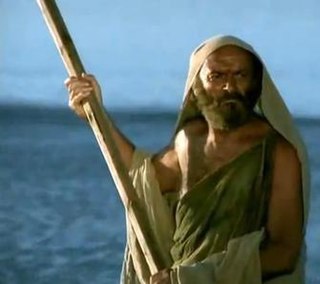
Genesis: The Creation and the Flood is a 1994 television film shot in Morocco, directed by an Italian film director, renowned Ermanno Olmi. It is based on the Book of Genesis, first book of the Hebrew Bible, where creation of the world and Great Flood are described.

















